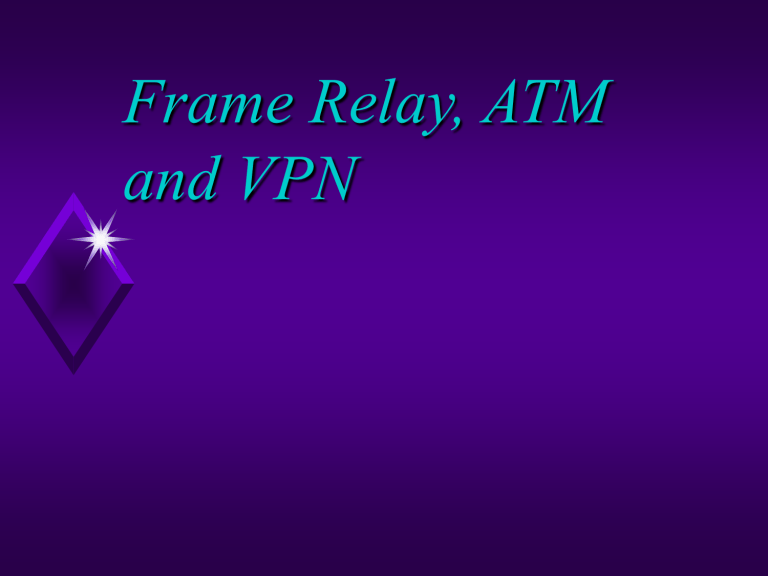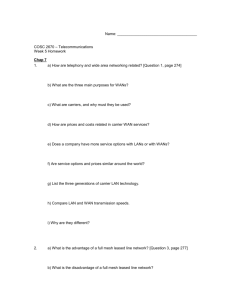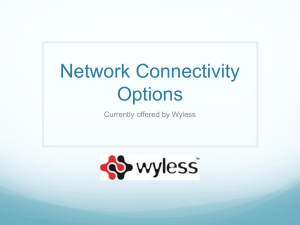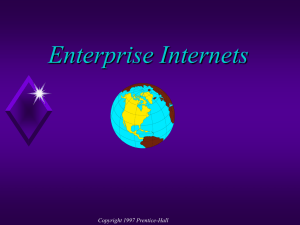Enterprise Internets

Frame Relay, ATM and VPN
Packet-Switched Services
Offered by Carriers
X.25
Old, slow, and not sufficiently cheaper than frame relay
Frame Relay
Speeds in main range of user demand
Attractive prices
Dominates the market today
ATM
High speeds and costs
2
X.25 Packet-Switched Data Networks
Oldest packet switched network service (1970s)
Low speed (maximum around 64 kbps)
Mature: easy to implement
Uses PVCs
Reliable service, so latency in transmission
Mostly replaced by Frame Relay
3
Frame Relay Packet-Switched Data
Networks
Software upgrade to X.25 switches
Uses PVCs
Unreliable, so much faster on same switches
Good speed range: 56 kbps - 40 Mbps: Meets most corporate needs (most under 2 Mbps)
Priced aggressively to kill leased lines
(succeeding)
Best-selling packet switched network service
See more here .
4
ATM (Asynchronous Transfer Mode)
Offers very high speeds
622 Mbps, 2.5 Gbps to 40 Gbps
Connection-oriented (PVCs), unreliable
Quality of Service (QOS) guarantees critical traffic
Minimize latency (delays)
Inherent reliability (low loss rate)
Technical details beyond this course
Building more bandwidth than needed
5
ATM
Speeds are beyond most corporate needs today
High costs
Seen as the next generation
But Frame Relay keeps increasing in speed in low
Mbps range where market demand is highest
Used by providers
e.g. AT&T, to support both ATM and Frame Relay for customers
See AT&T ATM pricing
6
Pricing Packet Switched Services
Customer Premises Equipment
Access Line to Point of Presence
Port Speed
Per PVC Price
Distance and Traffic Volume
7
Customer Premises Equipment
Access Device
Has link to internal system (often a LAN)
Has CSU/DSU to put internal traffic into format for
Frame Relay transmission
In Frame Relay, called Frame Relay Access Device
(FRADS)
Access Device Access Line to Network
LAN
8
Modular Routers
CSU/DSUs are removable expansion boards
Modular Router
Router Switching Circuitry
Port 1
CSU/DSU
(T1)
Port 2
CSU/DSU
(56 kbps)
Port 3
CSU/DSU
(T3)
Port 4
CSU/DSU
(56 kbps)
T1 Line 56 kbps Line T3 Line 56 kbps Line
9
Customer
Premises
A
Elements of a Packet Switched Network
LEC
Switching
Office
POP at LEC
Office
Leased
Access Line to POP
Leased
Access Line to POP
You need a leased access line to the network’s
POP.
Sometimes the packet switched network vendor pays the cost of the access line for you and bundles it into your service charges.
10
Elements of a Packet Switched Network
Switched
Data
Network
Trunk
Line
Network
Switching
Office
Customer
Premises B
Leased
Access Line
POP
11
Pricing of Frame Relay
Speed of the Access Line from Site to Network
Determines maximum transmission rate to the network
Often called the Port Speed (not in the book)
Often the most important price determinant
Must be fast enough for needs
See Frame Relay over DSL -- a price issue
12
Pricing of Frame Relay
In Some Frame Relay networks, two speeds
Committed Information Rate (pretty much guaranteed)
Available Bit Rate (like flying standby) for bursts. Not guaranteed.
Price depends both on CIR and ABR
Access line speed must be fast enough for ABR
13
Pricing of Frame Relay
Additional price per PVC
Usually small compared to the access line charge
One access line can multiplex all PVCs to/from site
PVCs share access line speed
Site
PVC1
PVC2
14
Calculations
Situation
You have four sites
You want any one to be able to reach any other
Questions
How many PVCs do you need?
How many access lines do you need?
15
Calculations
PVCs
If you have N sites, there are N(N-1)/2 possible connections
In this case, you would have 4(3)/2 or 6 possible connections
Some vendors count this as 6 PVCs, others as 12 PVCs
Access Lines
You would need four access lines (one for each site)
Each will multiplex 3 PVCs
Must be fast enough for the needs of communication with the three other sites
16
Pricing of Frame Relay
May Depend on Distance
But often a flat monthly rate throughout the carrier’s service area
May Depend on Traffic
But often a flat monthly rate based only on the speed of the access line
17
Leased Lines vs. Packet-Switched Data
Networks
Leased Lines
Point-to-point, inexpensive for thick routes
Inflexible: must be established ahead of time
Packet Switched Networks
Also must be established ahead of time for PVCs
Competitor for leased line networks
Priced aggressively
Carrier does all the management
Killing the leased line business
18
Circuit-Switched vs. Packet-Switched
Services
Circuit Switched Networks (ISDN, Switched 56)
Any-to-any connectivity by dialing number
Highest speed is ISDN: 64 kbps to 128 kbps
Packet Switched Networks (X.25, Frame Relay, ATM)
PVCs make them primarily competitors to leased lines
Megabit to gigabit speeds
SVCs may provide any-to-any flexibility in the future
IP services, MPLS , ATM trends
Note : more MPLS details
19
Virtual Private Network
VPN Server
Corporate
Site A
1.
Site-to-Site
Tunnel
Internet
2. Remote
Customer PC
(or site)
Extranet
VPN Server
Corporate
Site B
Remote
Access for
Intranet
3. Remote
Corporate PC
20
VPN advantage
Virtual Private Network (VPN)
Transmission over the Internet with added security
Some analysts include transmission over a PSDN with added security
Why VPNs?
PSDNs are not interconnected
Only good for internal corporate communication
But Internet reaches almost all sites in all firms
Low transmission cost per bit transmitted
21
VPN issues
VPN Problems
Latency and Sound Quality
Internet can be congested
Creates latency, reduces sound quality
Use a single ISP as for VoIP (voice over IP)
Security
PPTP for remote access is popular
IPsec for site-to-site transmission is popular
New IP services (see MCI offerings)
22
ISP-Based PPTP Remote Access VPN
Remote Access VPNs
User dials into a remote access server (RAS)
RAS often checks with RADIUS server for user identification information. Allows or rejects connection
Unsecure TCP
Control Channel
Local
Access
Secure Tunnel
RADIUS
Server
PPTP
RAS
Corporate
Site A
Internet ISP
PPTP
Access
Concentrator
23
VPN and PPTP
Point-to-Point Tunneling Protocol
Available in Windows since Windows 95
No need for added software on clients
Provided by many ISPs
PPTP access concentrator at ISP access point
Some security limitations
No security between user site and ISP
No message-by-message authentication of user
Uses unprotected TCP control channel
24
IPsec alternatives
IP Security (IPsec)
Tunnel mode: sets up a secure tunnel between IPsec servers at two sites
No security within sites
No need to install IPsec software on stations
Transfer mode: set up secure connection between two end hosts
Protected even on internal networks
Must install IPsec software on stations
25
IPsec in Tunnel Mode
Local
Network
IPsec
Server
Tunnel
Mode
Secure
Tunnel
IPsec
Server
Local
Network
No Security
In Site Network
Tunnel Only
Between Sites
Hosts Need No
Extra Software
No Security
In Site Network
26
IPsec in Transfer Mode
Local
Network
IPsec
Server
Transfer
Mode
IPsec
Server
Local
Network
Secure
Tunnel
Security
In Site Network
End-to-End (Host-to-Host)
Tunnel
Hosts Need IPsec Software
Security
In Site Network
27
Security at the internet layer
IP Security (IPsec)
At internet layer, so protects information at higher layers
Transparent: upper layer processes do not have to be modified
HTTP SMTP FTP SNMP
Protected
TCP UDP
Internet Layer with IPsec Protection
28
Common IPsec configuration
IP Security (IPsec)
Security associations:
Governed by corporate policies
Party A
List of
Allowable
Security
Associations
IPsec Policy Server
List of
Allowable
Security
Associations
Party B
29






